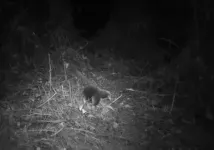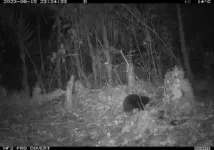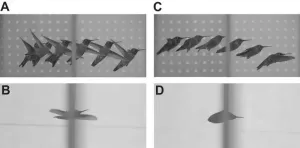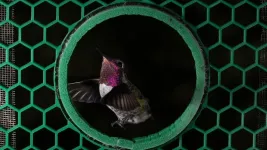(Press-News.org) A long-beaked echidna named after Sir David Attenborough and last seen by scientists in 1961 has been photographed for the first time in an Indonesian tropical forest.
An international team of researchers worked with local communities to deploy over 80 camera traps to film the elusive animal.
Besides rediscovering the echidna, the team uncovered a wealth of species completely new to science, including beetles, spiders, and a remarkable tree-dwelling shrimp.
A wide range of images and video footage from the expedition are available (see link below).
More than sixty years after it was last recorded, an expedition team has rediscovered an iconic, egg-laying mammal in one of the most unexplored regions of the world. Attenborough's long-beaked echidna, named after famed broadcaster Sir David Attenborough, was captured for the first time in photos and video footage using remote trail cameras set up in the Cyclops Mountains of Indonesia's Papua Province.
Alongside the echidna's rediscovery, the expedition – a partnership between the University of Oxford, Indonesian NGO Yayasan Pelayanan Papua Nenda (YAPPENDA), Cenderawasih University (UNCEN), Papua BBKSDA, and the National Research and Innovation Agency of Indonesia (BRIN), Re:Wild – made many other remarkable finds. These included Mayr's honeyeater, a bird lost to science since 2008; an entirely new genus of tree-dwelling shrimp; countless new species of insects; and a previously unknown cave system. This was despite the difficulties posed by extremely inhospitable terrain, including venomous animals, blood-sucking leeches, malaria, earthquakes, and exhausting heat.
One of the world's most unusual mammals finally caught on film
Recorded by science only once in 1961, Attenborough's long-beaked echidna is a monotreme: an evolutionarily distinct group of egg-laying mammals that includes the platypus. This echidna species is so special because it is one of only five remaining species of monotremes, the sole guardians of this remarkable branch of the tree of life. Echidnas are notoriously difficult to find since they are nocturnal, live in burrows, and tend to be very shy. Attenborough's long-beaked echidna has never been recorded anywhere outside the Cyclops Mountains, and is currently classified as Critically Endangered on the IUCN Red List of Threatened Species
To give themselves the best chance of finding one, the team deployed over 80 trail cameras, making multiple ascents of the mountains, and climbing more than 11,000 meters (more than the height of Everest) in the process. For almost the entire four weeks that the team spent in the forest, the cameras recorded no sign of the echidna. On the last day, with the last images on the final memory card, the team obtained their shots of the elusive mammal – the first ever photographs of Attenborough's echidna. The identification of the species was later confirmed by Professor Kristofer Helgen, mammalogist and chief scientist and director of the Australian Museum Research Institute (AMRI).
Dr James Kempton, a biologist from the University of Oxford who conceived of and led the expedition, said: ‘Attenborough's long-beaked echidna has the spines of a hedgehog, the snout of an anteater, and the feet of a mole. Because of its hybrid appearance, it shares its name with a creature of Greek mythology that is half human, half serpent. The reason it appears so unlike other mammals is because it is a member of the monotremes – an egg-laying group that separated from the rest of the mammal tree-of-life about 200 million years ago.’
‘The discovery is the result of a lot of hard work and over three and a half years of planning,’ he added. ‘A key reason why we succeeded is because, with the help of YAPPENDA, we have spent years building a relationship with the community of Yongsu Sapari, a village on the north coast of the Cyclops Mountains. The trust between us was the bedrock of our success because they shared with us the knowledge to navigate these treacherous mountains, and even allowed us to research on lands that have never before felt the tread of human feet.’
A treasure trove of discoveries
Alongside searching for the echidna, the expedition carried out the first comprehensive assessment of invertebrate, reptile, amphibian, and mammal life in the Cyclops Mountains. With the support of local guides in the expedition team, the scientists were able to create makeshift labs in the heart of the jungle with benches and desks made from forest branches and vines.
By combining scientific techniques with the Papuan team members’ experience and knowledge of the forest, the team made a wealth of new discoveries. These included several dozens of insect species completely new to science and the rediscovery of Mayr's honeyeater (Ptiloprora mayri), a bird lost to science since 2008 and named after famed evolutionary biologist Ernst Mayr.
An extraordinary finding was an entirely new genus of ground and tree-dwelling shrimp. ‘We were quite shocked to discover this shrimp in the heart of the forest, because it is a remarkable departure from the typical seaside habitat for these animals,’ said Dr Leonidas-Romanos Davranoglou (a Leverhulme Trust Postdoctoral Fellow at the Oxford University Museum of Natural History), lead entomologist for the expedition. ‘We believe that the high level of rainfall in the Cyclops Mountains means the humidity is great enough for these creatures to live entirely on land.’
The team also revealed a treasure trove of underground species, including blind spiders, blind harvestman, and a whip scorpion, all new to science, in a previously unexplored cave system. This astonishing discovery was made on one of the sacred peaks above Yongsu Sapari where the team had been given special permission to do research. People rarely tread here, and the striking cave system was chanced upon when one team member fell through a moss-covered entrance.
'A beautiful but dangerous land'
Extremely challenging and, at times, life-threatening conditions were at the background of these discoveries. During one of the trips to the cave system, a sudden earthquake forced the team to evacuate. Dr Davranoglou broke his arm in two places, one member contracted malaria, and another had a leech attached to his eye for a day and a half before it was finally removed at a hospital. Throughout the expedition, members were beset by biting mosquitoes and ticks, and faced constant danger from venomous snakes and spiders. Making any progress through the jungle was a slow and exhausting process, with the team sometimes having to cut paths where no humans had ever been before.
‘Though some might describe the Cyclops as a “Green Hell”, I think the landscape is magical, at once enchanting and dangerous, like something out of a Tolkien book’ said Dr Kempton. ‘In this environment, the camaraderie between the expedition members was fantastic, with everyone helping to keep up morale. In the evening, we exchanged stories around the fire, all the while surrounded by the hoots and peeps of frogs.’
An enduring legacy
Rediscovering the echidna is only the beginning of the expedition's mission. Attenborough's long-beaked echidna is the flagship animal of the Cyclops Mountains and a symbol of its extraordinary biodiversity. The team hope that its rediscovery will help bring attention to the conservation needs of the Cyclops, and Indonesian New Guinea more generally, and they are committed to supporting long-term monitoring of the echidna. Key to this work is NGO YAPPENDA, whose mission is to protect the natural environment of Indonesian New Guinea through empowerment of Indigenous Papuans. As part of the expedition team, members of YAPPENDA helped train six students from UNCEN in biodiversity surveys and camera trapping during the expedition.
Dr Davranoglou said: ‘Tropical rainforests are among the most important and most threatened terrestrial ecosystems. It is our duty to support our colleagues on the frontline through exchanging knowledge, skills, and equipment.’
With the team having only sorted a fraction of the material collected on the expedition, they expect that the coming months will yield even more new species. The intention is to name many of these after the Papuan members of the expedition.
Besides animal specimens, the team also collected over 75 kg of rock samples for geological analysis, which was led by the expedition's chief geologist, Max Webb, from Royal Holloway University, London. These could help answer many questions about how and when the Cyclops Mountains originally formed. The mountains are believed to have formed when an island arc in the Pacific Ocean collided with the New Guinea mainland about 10 million years ago. Combined with the biological findings, this geological work will help the team understand how the extraordinary biodiversity of the Cyclops came to be.
Notes for editors:
For media enquiries and interview requests, contact James Kempton: james.kempton@biology.ox.ac.uk +44 7954683094
A press pack of images and video footage (with captions) is available at: https://drive.google.com/drive/folders/1VV7FRWwf-B1kMQ2ClEjU6rR-y3bRgzr2 Images/video can be used in articles if credited.
More information about the expedition can be found at https://www.expeditioncyclops.co.uk/
About Attenborough's long-beaked echidna:
Attenborough's long-beaked echidna, Zaglossus attenboroughi, is not known to live outside the Cyclops Mountains and biologists still have many unanswered questions about its habitat and ecology.
Attenborough's long-beaked echidna is an EDGE species: a threatened species that has few close relatives on the evolutionary tree of life. They have evolved independently of other mammals for about 200 million years.
The echidna has cultural significance for the people of Yongsu Sapari, who have lived on the northern slopes of the Cyclops Mountains for eighteen generations. When there is a conflict within the community, rather than fighting, there is a tradition that one party goes up into the Cyclops to search for an echidna while the other party goes to the ocean to find a marlin. Both creatures were so difficult to find that it would often take decades or a whole generation to locate them, but, once found, the animals symbolized the end of the conflict and a return to harmonious relationships in the village.
The echidna has only been scientifically recorded once, when it was discovered by Pieter van Royen – a Dutch botanist – in 1961. Since then it has only been known from reports of sightings by the Yongsu Sapari community, and indirect signs during pre-expedition work in 2022. These signs, also observed during the expedition, included 'nose pokes,' holes in the ground left by echidnas after using their long, slightly curved snouts to probe for underground invertebrates.
About the expedition:
The expedition was first proposed in 2019 by James Kempton.
Academics who collaborated closely on the expedition include Dr James Kempton (University of Oxford), Dr Leonidas-Romanos Davranoglou (Oxford University Museum of Natural History), Madeleine Foote (University of Oxford), Dr Andrew Tilker (Re:wild, Leibniz Institute for Zoo and Wildlife Research), Dr Attila Balázs (Mendel University) and Dr Max Webb (Royal Holloway, University of London).
Cenderawasih University (UNCEN) team members and partners include Dr Suriani Surbakti, Gison Morib and Heron Yando.
Team members and collaborators from Indonesian NGO Yayasan Pelayanan Papua Nenda (YAPPENDA) include co-founders Iain and Malcolm Kobak, and Yali Kobak, Sampari Kobak, Ezra Daniel, Ruben Penggu, Melias Heluka, Yuanis Yalak and Sili Yalak.
The team obtained permits from Papua BBKSDA and BRIN. They were also given permission from the community of Yongsu Sapari to conduct research and collect specimens on their land during the expedition.
This rediscovery was made possible in part by the generous support of Merton College Oxford, the Royal Geographical Society, the Scientific Exploration Society, Re:wild, Royal Holloway University, the University of Oxford, Reconyx, and private donations from Derek Williams, Chris Peri, and other generous individuals.
About the Cyclops Mountains:
The Cyclops Mountains are one of the most inhospitable regions in the world, being rugged, steep, and dangerous, and ranging from sea level to 1,970 metres. They are dominated by two main peaks – Gunung Rara and Gunung Dafonsoro. When sailing ten leagues from the range's northern coastline in 1768, Baron Louis de Bougainville noted 'les deux cyclopes', from which the mountains bear their name.
The Cyclops Mountains are a Key Biodiversity Area, meaning that they are critical to the persistence of biodiversity and to the overall health of the planet.
The community of Yongsu Sapari have lived in the region for eighteen generations and hold the land as sacred. They believe it is stewarded by a female spirit who can take the form of a tree-kangaroo.
About the University of Oxford
Oxford University has been placed number 1 in the Times Higher Education World University Rankings for the eighth year running, and number 3 in the QS World Rankings 2024. At the heart of this success are the twin-pillars of our ground-breaking research and innovation and our distinctive educational offer.
Oxford is world-famous for research and teaching excellence and home to some of the most talented people from across the globe. Our work helps the lives of millions, solving real-world problems through a huge network of partnerships and collaborations. The breadth and interdisciplinary nature of our research alongside our personalised approach to teaching sparks imaginative and inventive insights and solutions.
Through its research commercialisation arm, Oxford University Innovation, Oxford is the highest university patent filer in the UK and is ranked first in the UK for university spinouts, having created more than 300 new companies since 1988. Over a third of these companies have been created in the past five years. The university is a catalyst for prosperity in Oxfordshire and the United Kingdom, contributing £15.7 billion to the UK economy in 2018/19, and supports more than 28,000 full time jobs.
END
Found at last: Bizarre, egg-laying mammal finally rediscovered after 60 years
2023-11-10
ELSE PRESS RELEASES FROM THIS DATE:
WHO updates its guidance on treatments for COVID-19
2023-11-10
A panel of international experts representing the World Health Organization’s Guideline Development Group has updated its guidance on treatments for patients with covid-19.
The new recommendations published by The BMJ are part of a living guideline, developed by the World Health Organization with the methodological support of MAGIC Evidence Ecosystem Foundation, to provide up to date, trustworthy guidance on the management of covid-19 and help doctors make better decisions with their patients.
The guidance ...
UTHealth Houston researchers awarded $2.6 million NIH grant to study molecular pathways and potential strategies for treatment of myocardial ischemia and reperfusion injury
2023-11-10
A four-year, $2.6 million grant to study circadian rhythm and novel therapies to protect the heart during a heart attack or cardiac surgery has been awarded to UTHealth Houston by the National Heart, Lung, and Blood Institute, part of the National Institutes of Health.
Principal investigator Holger Eltzschig, MD, PhD, professor, and co-investigator Wei Ruan, MD, PhD, assistant professor, from the Department of Anesthesiology, Critical Care and Pain Medicine at McGovern Medical School at UTHealth Houston, are studying translational, pharmacologic, and interventional strategies targeting ...
What human diseases can teach us about the immune system
2023-11-10
The immune system is a crucial part of our survival, regularly fending off wide-ranging attacks on the body, both internal and external. Unsurprisingly, the elegant defense system that protects us from viruses, bacterial infections, cancer, and other threats is immensely complicated. Each time it mounts a response, it must quickly and carefully orchestrate communication across vast numbers of cells and molecules.
Jennifer Oyler-Yaniv is working to figure out how, exactly, the immune system does this — and when and why it fails.
“There's always the next question, the next ...
Texas A&M researchers contribute to international project studying coronavirus transmission in humans, cattle
2023-11-10
Researchers from the Texas A&M School of Veterinary Medicine and Biomedical Sciences’ (VMBS) Veterinary Education, Research, and Outreach (VERO) program have joined an international team studying how coronaviruses are spread and whether an individual’s microbiome (the collection of microbes living in or on the body) might impact that transmission.
Coronaviruses are a family of viruses that can cause a variety of diseases in many species, from the common cold and severe acute respiratory syndrome (SARS) in people, to diarrhea in calves and respiratory disease in ...
NASA’s Webb, Hubble telescopes combine to create most colorful view of universe
2023-11-10
Astronomers once again have combined the observational powers of NASA’s James Webb Space Telescope and Hubble Space Telescope to create one of the most detailed and colorful portraits of the cosmos, just in time for the holiday season.
The new image, dubbed the Christmas Tree Galaxy Cluster by the research team that includes Texas A&M University astronomer Dr. Lifan Wang, combines visible light from Hubble with infrared light detected by Webb to showcase MACS0416, a galaxy cluster about 4.3 billion light-years from Earth. Because the cluster is able to magnify the light from more distant background galaxies through a phenomenon known as gravitational ...
Ten 2023 postdoctoral fellowships in aging research awarded by the Glenn Foundation for Medical Research and AFAR
2023-11-10
NEW YORK, NY and SANTA BARBARA, CA — The American Federation for Aging Research (AFAR) and the Glenn Foundation for Medical Research are pleased to announce the recipients of the 2023 Glenn Foundation for Medical Research Postdoctoral Fellowships in Aging Research. This program supports postdoctoral fellowswho study basic research mechanisms of aging and/or translational findings that have potential to directly benefit human health.
Selected through a rigorous review process, ten, one-year, $75,000 Postdoctoral ...
Mystery solved: how hummingbirds fly through gaps that are too small
2023-11-10
Soaring, wings outstretched, many birds sail through the air unhindered. However, species that dine on fruit, seeds and nectar must negotiate tiny gaps in cluttered foliage to secure a feast. To pass through apertures, many birds pull in their wings, folding them closer to their bodies. However, some of the most manoeuvrable aviators, hummingbirds, have lost the ability to fold their wings at the wrists and elbows. ‘Unless hummingbirds implement distinctive strategies to transit narrow apertures, they may be unable to enter gaps less than one wingspan wide’, ...
Hummingbirds' unique sideways flutter gets them through small apertures
2023-11-10
Most birds that flit through dense, leafy forests have a strategy for maneuvering through tight windows in the vegetation — they bend their wings at the wrist or elbow and barrel through.
But hummingbirds can't bend their wing bones during flight, so how do they transit the gaps between leaves and tangled branches?
A study published today in the Journal of Experimental Biology shows that hummingbirds have evolved their own unique strategies — two of them, in fact. These strategies have not been reported before, likely because hummers maneuver too ...
National analysis suggests that potentially serious complications occur in 1 in 18 procedures under the care of an anaesthetist
2023-11-10
New survey data from the 7th National Audit Project of the Royal College of Anaesthetists (NAP7) published in Anaesthesia (the journal of the Association of Anaesthetists) shows that potentially serious complications occur in one in 18 procedures under the care of an anaesthetist.
The risk factors associated with these potentially serious complications include very young age (babies); comorbidities; being male; increased frailty; the urgency and extent of surgery; and surgery taking place at night and/or at weekends.
This paper has been produced by a team of authors across ...
Study finds that laser epilation reduces risk of recurrence of pilonidal disease
2023-11-09
Laser epilation, commonly known as laser hair removal, reduced the risk of recurrence in patients with pilonidal disease, an inflammatory, painful, and sometimes chronic or recurring condition, according to research conducted by Peter C. Minneci, M.D., Chair of Surgery at Nemours Children’s Health, Delaware Valley, and published in JAMA Surgery.
Pilonidal disease occurs when cysts form between the buttocks. It is believed to be an inflammatory reaction to hair or debris that gets caught in the crease of the buttocks. The disease occurs in 26 to 100 per 100,000 people and is most common in adolescents and young ...







